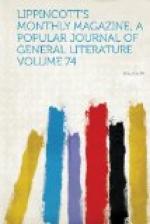The lakes of the lately-traversed “Lake Region,” frequent as they had been, were as nothing to those of Ekoniah Scrub. The road rose and fell over a succession of low hills, each ascent gained discovering a new sheet of water to right, to left or before us, deep sunk among thick-clustering trees. At rare intervals the forest would fall away on either hand, opening up a wide view of cultivated fields, sweeping grandly down in long stripes of tender green to the billowy verdure of the broad savanna, where silvery-sparkling lakes lay imbedded and great round “hummocks” of dark trees uprose like islands in the grassy sea. In the distance would be barren slopes of rich dark red and silvery gray, swelling upward to the far dim mystery of pine woods and the blue arch above.
We ate our dinner beside Lake Rosa, a circular basin of clearest water rippling and dimpling under the soft breeze. Toward evening we found the ford, which a paralytic old woman sitting in a sunny corner of a farm-house piazza had indicated to us as “right pretty.” Pretty it was, indeed, as we came down to it through the most luxuriant of hummocks of transparent-foliaged sweet-gums and shining-leaved magnolias with one great creamy flower. “Right pretty” it was, too, in the old woman’s meaning of the word, for Barney drew us through in safety, scarce up to his knees in the transparent water which reflected so perfectly every flower and leaf of the dense water-growth. The road beyond was cut through an arch of close-meeting trees, and farther on it skirted a broad lake, which already, in its slow, sure, upward progress, had covered the roadway and was reaching even to the fence which bounds the field above. In this field is a large mound, never investigated, although the farmer who owns the property says he has no doubt that it is the site of an Indian village, for the plough turns up in the fields around not only arrow-heads, but fragments of pottery and household utensils. It was not our good-fortune to obtain any of those relics, as they have not been preserved, and this was the only mound of any extent which we saw. Such mounds are said, however, to be not infrequent in this district, and Indian relics are found everywhere.




